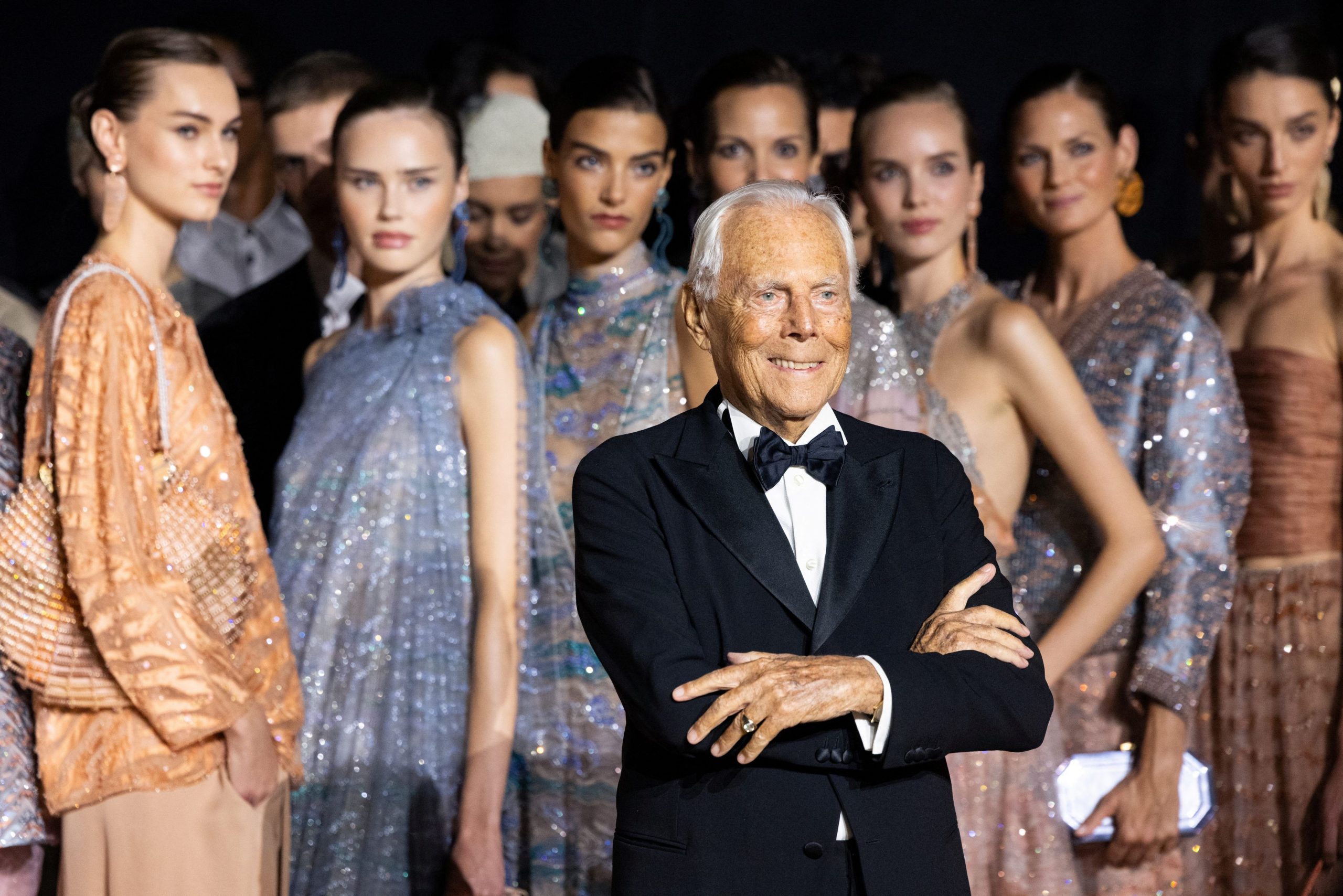Giorgio Armani, the 90-year-old Italian fashion designer, has never liked being called “the king.”
While there are aspects of Armani’s life that are incontestably royal—the multibillion-dollar, privately owned, globe-spanning company; the glossy green superyacht; his enduring leadership—he said in a rare sit-down interview that he found the title often bestowed upon him “ridiculous.” The perennially tan billionaire continued that he’s known a lot of monarchs in his day, and dressed many of them, but that he “works like anyone else.”
This week alone, Armani celebrated nearly 50 years of his fashion and lifestyle company with a spring fashion show featuring 93 outfits and a gala event, and opened a 12-floor building on Madison Avenue, complete with clothing and home boutiques, a forthcoming restaurant and 10 residences, which started at $21.5 million. They are already sold out, according to a representative for the building’s broker, Douglas Elliman. Armani saved an apartment for himself; it will be his second home in New York City, a place he hasn’t visited since 2013.
Despite his aversion to royal titles, Armani confessed, “I built a little palace.”
It’s a victory lap for Armani, the sole shareholder of a company that has remained independent since its founding in 1975. As chairman and chief executive, in addition to overseeing all creative, Armani still exerts a firm grip on his sprawling empire. With over $2.6 billion in revenue in 2023, that includes men’s and women’s lines, the Emporio Armani diffusion line, Armani Privé haute couture, interiors, dozens of restaurants, 2,500 retail stores, fragrances and a cult-classic beauty line. His work is distinguished by restrained sophistication, whether that’s discreet red-carpet looks for Lupita Nyong’o and Leonardo DiCaprio or low-key leather jackets.
Armani’s signatures, including the color “greige,” relaxed tailoring and beaded evening wear, were all on display at Thursday’s show at the Park Avenue Armory. Afterward, guests including Pamela Anderson and Orlando Bloom mingled over small bowls of saffron risotto and Armani’s favorite, pasta pomodoro. “‘That’s so Armani’ is the nicest thing you can say to anyone,” Michael Kors said at the party.
Industriousness is key to Armani’s longevity. “Work is the best medicine,” the designer said between fittings for his show last week, in a quiet backroom of a bustling temporary workspace on the Upper East Side of Manhattan. He credits daily work with resolving some health issues this summer: “As soon as I started working again, I felt better.”
Wearing his customary navy cashmere sweatsuit and white sneakers, and speaking in an elegant French—his second language—Armani seems as sharp as ever. “I just pretend to be lucid,” he joked.
He’s setting up the company for his inevitable departure. Although he has no children, Armani’s circle of close collaborators includes several family members. There’s his sister Rosanna, who is on the board of directors; his niece Silvana, who is the head of women’s design; his niece Roberta, the head of VIP and entertainment relations; and his nephew Andrea Camerana, the sustainability managing director. His right-hand man is head of menswear Pantaleo (Leo) Dell’Orco, who is a close friend and has come out to take a bow with Armani after the show recently. In 2016, Armani filed paperwork outlining how the company should be handled by these heirs, including for an eventual public listing or any merger or acquisition. The trust also includes a charitable foundation.
“I’ve always prepared my collaborators for the next chapter,” Armani said. “There are people who are at the level that they need to be, some that are a bit less.” Ever the perfectionist, he seems to feel that the indoctrination of his mission is not yet complete.
The most crucial lesson he wants to impart? “Humbleness,” he said. “Sometimes people in this business have strong egos, and it’s important to remain modest.”
For Armani, independence has always been “extremely important,” he said. “It’s not a question of pride. It’s about getting things done. When I have an idea, I want to see it through to the end.”
So far, that’s worked. “Armani has been big enough and profitable enough to stand up in the industry and play in the premier league without a need to sell out to a larger group,” said Luca Solca, global luxury goods analyst at Bernstein. He said it was “definitely an appealing acquisition target, if it ever came available.”
Armani said he does get approached by big luxury conglomerates about buying his brands. “And now that I’m 90, they come even more often. They think it’s a good time to get in.”
He always tells them the same thing: “It’s not the right time.”
When exactly Armani will step down is anyone’s guess. Armani recently told Italian newspaper Corriere della Sera that he’d retire in two to three years, and it was widely reported as gospel. “I said that as a joke,” he said, smiling. “Because we don’t really know what will happen.”
Armani, born in 1934 in the northern Italian city of Piacenza, attended medical school before serving in the army. Upon realizing a penchant for design, he worked as an assistant architect for a Milanese department store.
After designing menswear for Nino Cerruti, Armani founded his company in Milan in 1975 alongside his late romantic and business partner Sergio Galeotti. He became a global household name when he designed Richard Gere’s sprezzatura wardrobe for the 1980 movie “American Gigolo.” In the 1980s and ’90s (and still today ), Armani was the go-to guy in Hollywood for subtle red-carpet looks, from Diane Keaton and Jodie Foster’s soft suits to tuxes for pretty much every leading man.
While his appeal never truly waned, an interest in Armani-inflected minimalism and everything ’90s has given the designer new momentum among a new generation of fans, who seek out his vintage pieces. Streetwear retailer Kith and Swedish brand Our Legacy have collaborated with the brand on youth-focused collaborations. On a recent podcast, Australian tailoring guru Patrick Johnson said Armani was “the number one” inspiration.
Armani is fully cognizant of the nostalgia surrounding his work. “There’s always an Armani touch in what I do, even now,” he said. “But I sense that I need to renew myself. Change with the times, but with discretion, with a very careful attention to not exaggerate, or follow what I see.”
Customers want to see fresh ideas—like the sparkling peridot fine jewelry, collarless jackets and delicate white oxford shoes on display at Madison Avenue this week—but they come to Armani for its dependability.
“He has had such a beautiful consistency to his offering,” said Darcy Penick, president of Bergdorf Goodman. The ultimate uptown department store, under its legendary fashion head Dawn Mello, was an early proponent of Armani’s and continues to sell it well, especially jackets, tailoring and evening wear. Penick said it’s still a “go-to” for top-tier Bergdorf clients.
Armani visited Bergdorf this week to meet with store associates and top clients. When he’s in New York, he loves seeing what young people are wearing on the streets. Fans are less shy these days about coming up to him and asking for selfies. “Sometimes it’s nice,” he said. Sometimes, less so.
“I like being alone,” he said. Watching movies is still one of his passions, although he’s unconvinced by streaming television and contemporary cinema (“What I really want to see is ‘Gone with the Wind.’”). He’s compulsively orderly, and at nighttime he will often tidy up, or rearrange his objects at home.
Ultimately, said Armani, “I want to live a little longer.” He knows he’ll miss his houses in New York, on the Italian island of Pantelleria, his little cats Miu and Wolf, his family. “To leave life is hard. I am preparing myself for it to be even harder than I expect.”
Write to Rory Satran at rory.satran@wsj.com










